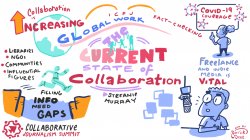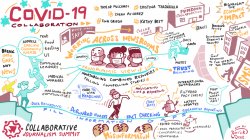Collaboration in a New Era
Center for Cooperative Media turns a challenge into an opportunity with virtual global summit
Posted in: Communication and Media, University

As events across campus and around the world were being canceled or postponed this spring, Montclair State University’s Center for Cooperative Media (CCM) quickly pivoted to convert its in-person annual Collaborative Journalism Summit to an in-place virtual event. The effort to showcase news organizations and community partners working together to reach audiences and pool resources was made even more pressing by the global pandemic.
“It was an easy decision for us to make,” CCM Director Stefanie Murray told virtual attendees last week, via a Zoom address. “We knew we couldn’t postpone because collaboration is especially important right now.”
Instead of travelling to Charlotte, North Carolina, where the summit was originally scheduled to take place, more than 750 registered attendees and 70 speakers fired up their devices from remote locations globally and signed in for two days of panels, roundtables, workshops, networking and socializing on May 14 and 15. The summit, now in its fourth year, typically draws 150-200 attendees.
“This is the biggest summit we’ve ever hosted,” reported Murray. The Center kept the Zoom webinar format lively and engaging with live note-taking, live transcription, a live chat, ongoing Q&A, live graphic illustration and four different networking break rooms – plus bingo cards and CCM-specific hip-hop jams playing in the background between events.
But there was no escaping the seriousness of “the moment.”
“I also want to take a moment to acknowledge the moment we’re all in,” said Murray. “In the midst of a pandemic, I know many of you joining us today have been working long hours; you’ve become caretakers for relatives, for your grown children, for your very young children; some of you are have been furloughed or laid off; I know many of you don’t have steady work, and others who are working, I know you’re nervous about your future. I hope over the next day and a half, we can focus on the good work that we can do together when we collaborate around the world; I hope we can lift up that work and hold space to figure out how to build partnerships that strengthen our communities.”

The conference started by highlighting the work of the year-old Charlotte Journalism Collaborative and the North Carolina Local News Lab Fund. “North Carolina is truly the state of collaboration,” said Murray. Throughout the two-day event, sessions and workshops also spotlighted community engagement, combatting disinformation, covering elections, dealing with constraints and obstacles due to the COVID-19 pandemic, sharing revenue, and more.
No matter the topic, collaborative journalism was the unifying theme.
Participants and practitioners credited collaborative approaches for helping them reach broader audiences, take on more ambitious investigative work and meet the demands of reporting on the unprecedented global COVID-19 crisis.
Glenn Burkins of Q City Metro explained, “We are in this together. No single organization has it all. No one has all the resources and no one has the entire audience.” He ascribed the success of the Charlotte Journalism Collaborative to a spirit of cooperation that has been antithetical to traditional journalism: “We’ve put aside the ego, the competitive nature. Let’s face it – we are journalists and we love to compete. There is a place for that but there’s also a place for coming together and doing what’s best for the audience, especially at a time when there are limited resources.”
Sarah Alvarez of Outlier Media noted that many journalists’ approaches have changed because of the pandemic: “COVID-19 really focuses people to just get to work and get over it.”
The Summit also addressed building audiences – in terms of reaching underserved populations, hiring and promoting journalists of color, and building confidence in the media.
“There’s a lot of media distrust and we have to overcome that,” said Ju-Don Marshall, chief content officer at WFAE 90.7 and Murray’s predecessor at CCM.

Addressing the summit on Day 2, Keith Strudler, director of the School of Communication and media at Montclair State, said that academia and journalism are facing many of the same challenges. “We’re looking at new ways to reach the public just like journalists, using new tools and having to collaborate with people we thought of as our competitors.”
“The Center for Cooperative Media, led by Stefanie – all the work they do for the School of Communication and Media and the journalism community – is invaluable. They help make our school what it aspires to be. We are always thrilled to have them share their knowledge and information with our school and our faculty.”
“As you are in your local communities looking for different ways to tell your stories, I hope you will similarly find these young aspiring minds in your communities to help solve these problems,” said Strudler.
“I want to say thank you to the journalists on the front line,” said Jennifer Preston of the Knight Foundation, one of the Summit’s key sponsors. “All of you who are putting aside past competitive urges and coming together to serve everyone in the community at this time. Making sure people have lifesaving information is key.”
The entire cost of the 4th Annual Collaborative Journalism Summit was supported by the following sponsors: NC Local News Lab Fund, Montclair State University, Knight Foundation, American Press Institute, Democracy Fund, John S. Knight Journalism Fellowships, Google News Initiative, EducationNC and Journalismo Collaborativo.
Story by Staff Writer Mary Barr Mann.
